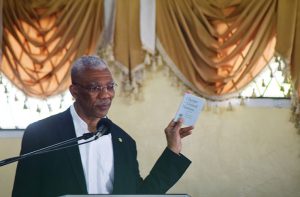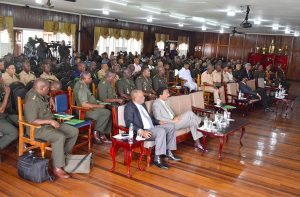THE Reserve Force of the Guyana Defence Force (GDF) will once again be established said President Granger, who welcomed the announcement by Chief of Staff, Brigadier Patrick West, at the opening of the Force’s Annual Officers’ Conference held at Base Camp Ayanganna on Thursday.
President Granger noted that when established it would be on “equal footing with the regular force” in accordance with the requirements in the Defence Act.
“The Defence Act prescribes that the GDF shall consist of a regular force and a Reserve Force; it was therefore never the intention of the framers of the Act that the Reserve Force should ever be diminished or discontinuous and I am happy that the Chief of Staff has announced that the Reserve Force will once again be established on equal footing with the regular force as called for in the Defence Act,” the President stated.
He said the doctrine of total and national defence must be a comprehensive one “given our limited financial and material resources, and by force of circumstance, the defence doctrine must be based on maintaining a small regular force and a relatively large reserve force which can be deployed to all parts of the country to respond to emergencies.”

The President, a retired brigadier, said the doctrine of national defence can be explained by what he terms vertical augmentation and horizontal amalgamation.
“By vertical augmentation I mean that if you have a small regular force it can be augmented by the addition of reservists sections could be built into platoons and platoons can be built to combat teams, combat teams can be built into battle groups and battle groups can be built into task forces by reservists when the need arises.”
While, by horizontal amalgamation, it means that by establishing reserves in each administrative region, those units would be in closer proximity in both time and space to events and emergency situations.
PROMPT RESPONSE
“It means they could respond more promptly when a situation arises, whether an incursion or flood. They are on the ground, on the spot… our forces must be spread in all 10 regions of the country — this is not a coastal force, not an urban organisation; this is a national defence force,” the Commander- in- Chief stated.
Meanwhile, President Granger reminded that the Force would be unable to effectively discharge its mandate of guardianship of territory unless it has the assets and ability to deploy its troops across the length and breadth of Guyana.
He reminded the officers of his first address to them as President in October 2015 where he called for the Force to ensure that at the national level both the regular and reserve levels are brought up to strength.
“I instructed that the Reserve Force must be maintained in sufficient strength in the capital town of every administrative region; bar none. We must enhance the technical capability of the air corps, the artillery corps, engineer corps and the coast guard in addition to maintaining the efficiency of the ground forces,” the President stated.

Additionally, he noted that the inadequacy of the country’s hinterland infrastructure, insufficient bridges, aerodromes, highways and stellings hinder access and impedes deployment.
“It is essential therefore that these factors be considered in designing and refining our defence doctrine,” he stated.
President Granger said too that his Government has pursued friendly relations with all states including Brazil, China, UK, USA and elsewhere where officers have been and continue to be trained.
Guyana, he said continues to have cordial relations with Canada, Germany, French Guiana and sister states in Caricom. Government, he said is engaging friendly governments with the view to enforcing its technical arm and noted that over the next three years evidence will be seen.
President Granger also reminded those gathered at the conference that the Force must be constantly ready to deploy troops effectively and at a short notice to conduct operations at any time of the day and at any location.
PROGRESSIVE STRIDES
He noted that threats in the form of domestic and transnational crimes are being reduced because of the GDF’s performance of its role.
“Maritime piracy has diminished because of more robust surveillance by the air corps and coast guard and by the combined task force of the GDF and GPF. Our ground forces continue to maintain vigilance on our borders, coastland and in our rivers,” he stated while reminding officers that threats to Guyana’s security are of both long standing circumstances and of recent occurrence.
He believes that Guyana must pursue a tripartite path in accordance with its national interest and in accordance with the Charter of the United Nations and noted that, that path is based on national self-defence.
President Granger stressed that the Ministry of Foreign Affairs has always been and will continue to be this country’s first line of defence. However, he turned his attention to internal threats which he said may seek to undermine internal security.
“Reckless remarks about an uprising and provocative calls for the mobilisation of foot soldiers have the potential to rip apart the fragile fabric of social cohesion that we enjoy,” the President stated.
He added: “The doctrine of total national defence must be based formally not only on military defence but on civil defence and social and environmental defence. These pillars cannot be buttressed by the Force alone or even the Government; national defence doctrine must emphasise the importance of every citizen taking personal responsibility for our national patrimony,” he stated.


.jpg)











